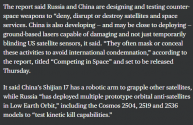No, hopefully because people are learning that posting SCMP Stephen Chen articles is a waste of everyone's time.
You are using an out of date browser. It may not display this or other websites correctly.
You should upgrade or use an alternative browser.
You should upgrade or use an alternative browser.
PRC/PLAN Laser and Rail Gun Development Thread
- Thread starter SinoSoldier
- Start date
I know it's a Stephen Chen article, but this one refers to a published paper by the Chinese rail gun research team. However, I was unable to find the paper that the article refers to.
The Chinese navy has tested an electromagnetic rail gun, firing a smart bomb 15km (9 miles) high into the stratosphere at a speed exceeding , according to scientists involved in the project.
...
With a pair of gliding wings, the precision-guided projectile descended along a relatively gentle curve and hit the ground after about three minutes in flight.
But the test was later declared unsuccessful.
“The projectile did not follow the expected trajectory and the maximum range and altitude did not meet the design values,” said the Naval Engineering University team led by Lu Junyong in a peer-reviewed paper published by the academic journal Transactions of China Electrotechnical Society.
After scrutinising data transmitted back to the ground by the smart bomb, Lu’s team discovered that the projectile was rotating too fast during its ascent, resulting in an undesired tilt.
With the help of technology, Lu and his colleagues were able to identify the cause of the failure and find solutions to overcome this technical hurdle impeding the practical application of rail guns.
According to the mechanical sensor data provided in the paper, the projectile accelerated at roughly 35 times the force of gravity for around 5 seconds after launch, confirming the researchers’ claim that it exceeded hypervelocity, or Mach 5.
No details were given on the time and location of the test, although it must have occurred before August 2023 when the paper was submitted to the journal.
If "after launch" means after the projectile leaves the muzzle of the rail gun, how is it possible for that projectile to still accelerate at greater than 1 G greater after that?According to the mechanical sensor data provided in the paper, the projectile accelerated at roughly 35 times the force of gravity for around 5 seconds after launch, confirming the researchers’ claim that it exceeded hypervelocity, or Mach 5.
So this was done with the railgun that is attached to that test ship? How does that compare with traditional naval guns in use today?
I don’t think the test ship has a long enough rail, not if it only accelerates at 35G. This must have been done at a test site with a 5km track. I believe CRRC has one for mag lev testing and even evacuate air tubes. Unless it has a much higher acceleration on the rail, and the 35G is referring to post-launch acceleration from some engine.So this was done with the railgun that is attached to that test ship? How does that compare with traditional naval guns in use today?
Maybe deacceleration due to air drag?If "after launch" means after the projectile leaves the muzzle of the rail gun, how is it possible for that projectile to still accelerate at greater than 1 G greater after that?
Last edited:
It's possible because Stephen Chen is an idiot who doesn't understand high school physics.If "after launch" means after the projectile leaves the muzzle of the rail gun, how is it possible for that projectile to still accelerate at greater than 1 G greater after that?
Quickie
Colonel
It should be. In the gun barrel, the bullet accelerates at the rate of tens of thousands of G. Rail gun should be even higher G.Maybe deacceleration due to air drag?
Quora:
"The explosion gradually accelerates the bullet over the length of the barrel. If the barrel is 2 ft long, then you can calculate the average acceleration since the velocity is the sqrt of 2ad so a=9,000,000/2x2=2.2 million f/sec*sec or 70,000 g's.11 Feb 2018"
Last edited:

